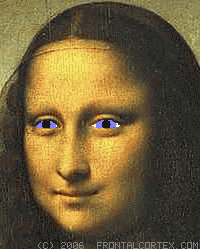
Disorders of Ocular Motility 2
Topic: Adult
Created on Thursday, August 31 2006 by jdmiles
Last modified on Friday, December 15 2006.

A) Posterior commissure
B) Left medial longitudinal fasciculus
C) Left cranial nerve VI
D) Bilateral medial longitudinal fasciculi
E) Right medial longitudinal fasciculus
This question was last modified on December 15, 2006.
ANSWERS AND EXPLANATIONS
A) posterior commissure
This answer is correct.
This patient has Parinaud syndrome, a palsy of vertical gaze which can result from a lesion of the posterior commissure. When the patient tries to look up, her eyes converge and retract; this is known as conversion-retraction nystagmus. (See References)
 |  |  | 
|  |  |
| Please log in if you want to rate questions. | |||||
B) Left medial longitudinal fasciculus
This answer is incorrect.
A lesion of the left medial longitudinal fasciculus would present as impaired adduction of the left eye, with nystagmus in the right eye when it is abducted. (See References)
 |  |  | 
|  |  |
| Please log in if you want to rate questions. | |||||
C) left cranial nerve VI
This answer is incorrect.
A lesion affecting the abducens nerve (CN VI) would result in impaired abduction of the eye ipsilateral to the lesion. This patient has impaired adduction of the left eye, with normal abduction. (See References)
 |  |  | 
|  |  |
| Please log in if you want to rate questions. | |||||
D) bilateral medial longitudinal fasciculi
This answer is incorrect.
A lesion of both medial longitudinal fasciculi would present as bilateral impairment of adduction, with nystagmus in the abducted eye on congugate lateral gaze. (See References)
 |  |  | 
|  |  |
| Please log in if you want to rate questions. | |||||
E) right medial longitudinal fasciculus
This answer is incorrect.
A lesion of the right medial longitudinal fasciculus would present as impaired adduction of the right eye, with nystagmus in the left eye when it is abducted. (See References)
 |  |  | 
|  |  |
| Please log in if you want to rate questions. | |||||
References:
| 1. Victor, M., and Ropper, A.H. (2001). Adams and Victor's Principles of Neurology, 7th Edition. McGraw-Hill, New York. Pp. 289. | |
| 2. Wall, M. (2004). Brainstem Syndromes. In In Bradley, W.G., Daroff, R.B., Fenichel, G.M., and Jankovic, J. (Eds.). Neurology in Clinical Practice, 4th Edition. Butterworth Heinemann, Philadelphia. Pp. 273-286. | |
| 3. Leigh, R.J., and Zee, D.S. (2006). The Neurology of Eye Movements, 4th Edition. Oxford University Press, Oxford. | |
| 4. Bickley, L.S., and Hoekelman, R.A. (1999). Bates' Guide to Physical Examination and History taking, 7th Edition. Lippincott, Philadelphia. Pp. 163-244. |
 |  |  | 
|  |  |
| Please log in if you want to rate questions. | |||||
FrontalCortex.com -- Neurology Review Questions -- Neurology Boards -- Board Review -- Residency Inservice Training Exam -- RITE Exam Review
adult
Disorders of Ocular Motility 2
Question ID: 831200602
Question written by J. Douglas Miles, (C) 2006-2009, all rights reserved.
Created: 08/31/2006
Modified: 12/15/2006
Estimated Permutations: 600
User Comments About This Question:
log in to FrontalCortex.com
New to FrontalCortex?
|

















